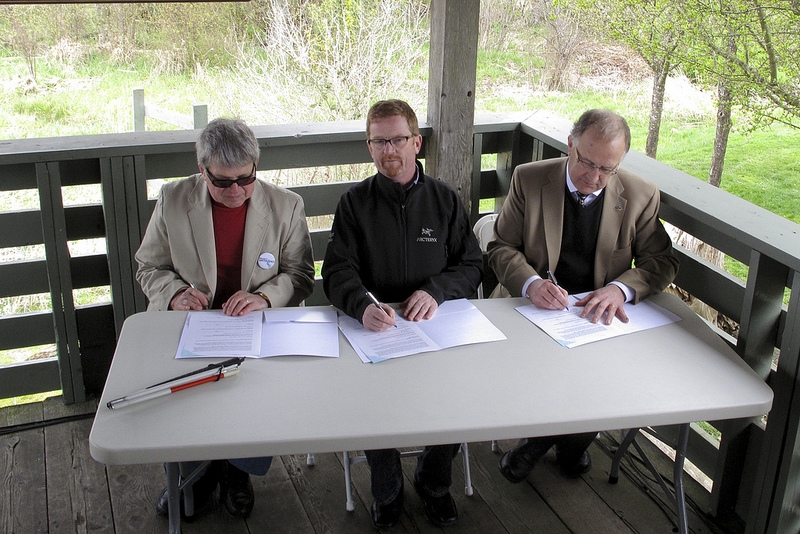The following article was posted in The British Columbia Newsroom and The VIU News.
Issued by the BC Ministry of Environment, April 9, 2013
COURTENAY – The B.C. government is partnering with Vancouver Island University and the Comox Valley Project Watershed Society to better understand how coastal communities can combine action on climate change and improvements to coastal ecosystems, and at the same time potentially benefit economically from these activities.
The Province, Vancouver Island University and Comox Valley Project Watershed Society have signed a Memorandum of Understanding (MOU) and identified opportunities – starting in the Comox Valley – for these blue carbon projects in B.C.
To contribute to the success of the agreement, the Ministry of Environment is providing $30,000 to commission a first phase of scientific research planning. Blue carbon is the carbon stored in the marine environment, shellfish, plants and sediment. Healthy estuaries remove and store carbon dioxide – possibly even more effectively than plants on land.
B.C. has 27,200 kilometres of coastline and 422 estuaries to work with. Blue carbon projects have climate change reduction and adaptation benefits, as well as economic and environmental opportunities for communities and First Nations along the B.C. coastline.
The parties have agreed to:
- Identify additional eligible project areas for blue carbon project activities along the B.C. coast.
- Evaluate the reasonable cost per tonne to undertake various blue carbon projects, including key variables in forecasting costs (i.e., accessible vs. inaccessible coastline).
- Undertake projects involving a wide range of shoreline and estuary protection and habitat restoration activities on private and public lands that can be designed, developed, quantified and verified to meet domestic and international quality standards.
- Undertake the necessary research and analysis to support the creation and sale of greenhouse gas offsets from blue carbon projects that will be recognized as quality offsets in international markets.
Through these activities, Vancouver Island University will increase its ability to respond to coastal community needs and meet the educational goals of its students. The Province will better understand the opportunity to combine community action on dealing with the impacts of a changing climate, climate change reduction and ecological improvement in coastal ecosystems.
Comox Valley Project Watershed Society will build local expertise and capacity, and restore valuable intertidal areas to the benefit of B.C. coastal and First Nations communities.
Quotes:
Environment Minister Terry Lake – “By leveraging blue carbon, we have the opportunity to reduce the risk of sea level rise and ocean acidification, and repair centuries of habitat destruction. Blue carbon also supports community-based efforts to create climate change solutions locally and will make possible cultural, economic and environmental benefits.”
MLA (Comox Valley) and Education Minister Don McRae – “Blue carbon is the point where ecological restoration, greenhouse gas reduction and climate change adaptation converge. With our unrivaled knowledge in ecosystem and climate change science, strong policies to drive investment in sequestration and a world-leading approach to dealing with the impacts of a changing climate, B.C. possesses the tools and expertise the world is looking for. The end result will hopefully be the creation of sustainable jobs in coastal areas of B.C. such as the Comox Valley.”
Dr. Ralph Nilson, president and vice-chancellor, Vancouver Island University – “Preservation and restoration of coastal marine ecosystems is essential to support the sustainability and quality of life in the coastal communities that Vancouver Island University is proud to serve. We are delighted to be a part of the research and restoration efforts that will not only have a positive local impact but potential global application in mitigating climate change.”
Paul Horgen, chair, Comox Valley Project Watershed Society – “Eelgrass meadows are disappearing from coastal estuaries as a result of pollution, habitat destruction and burial. Their loss is a loss of an important natural carbon sink. Restoration efforts have economic and climate adaptation benefits, and provide key wildlife habitat – a hat trick for the environment. We look forward to working with the Province and VIU to make the Comox Valley blue carbon project a local effort with international ramifications.”

(Left to right): Project Watershed’s Dr. Paul Horgen, Minister of Environment Hon. Terry Lake and VIU President Dr. Ralph Nilson signed a three way Memorandum of Understanding between the University, Project Watershed and the BC Government (via, Ministry of Environment and the Climate Action Secretariat to work together to investigate “Blue Carbon” and its role of estuaries in sequestering carbon.
Learn More:
- British Columbia Newsroom – Media Relations, Ministry of Environment, 250 953-3834
- Vancouver Island University – Don Tillapaugh, Director Centre for Shellfish Research at Don.Tillapaugh@viu.ca

